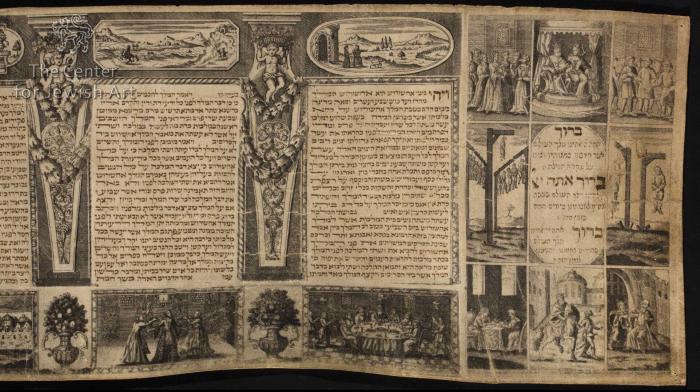Img. ID: 332793

Opening decoration: the scroll opens with a panel containing several narrative scenes from the Esther story. In the decorative panel, in the central part of the upper register, there is the royal couple seated on the throne with a canopy that is placed on a pedestal. The king and the queen are accompanied by courtiers; on the right, the princes of Media and Persia are standing (Es. 1:14) and on the left, Esther's maidservants are standing (Es. 2:9). Below, there are three rectangular frames: the central panel contains the benedictions recited before the Megillah reading, while the panel on the right shows the chamberlains, Bigthan and Teresh, hanging on two gallows (Es. 2:23), whereas the one on the left depicts Haman and his sons hanging on three gallows (Es. 7:10 and Es. 9:14 or Es. 9:25). The lowest register contains three episodes that are (from right to left): Mordecai receiving the clothes from Hatakh (Es. 4:4), Haman leads Mordecai through the streets of Susa (Es. 6:11), Esther and Mordecai write letters instructing the Jews to observe Purim (Es. 9:29).
The first membrane of the scroll includes also the first four text columns (nos. 1-4), and four frames with the narrative scenes (nos. 1-4). Only two of the text columns and narrative scenes are visible in the image.
Column 1: In the upper margin, landscape no. 1 is printed and in the lower margin, the feast of Ahasuerus is represented (Es. 1:3-8). Six men are seated at a round laid table. On either side of the table, servants are visible.
Column 2: In the upper margin, landscape no. 2 is printed and in the lower margin, Queen Vashti is portrayed while she is strangled by two women standing on either side of her. During the execution, she stands with her arms spread, and her crown lies on the floor. The Book of Esther does not mention the fate of Vashti after her refusal of the king's order and the source for this representation remains unknown.
Length of the sheets in the scroll: 1) ca. 485 mm, 2) ca. 400 mm, 3) ca. 390 mm, 4) ca. 420 mm (the sheets are wavy, therefore it is difficult to measure them carefully).
Dimensions of the selected details in the scroll:
- decorations in the upper margins: ca. 32 mm;
- decorations in the lower margins: ca. 38 mm;
- text panel: 64 mm (width);
- spaces between the text panels: ca. 27 mm;
- frames with illustration(s): 38x73 mm;
- an average square letter: 2 mm (height);
- an average semicursive letter: 2 mm (height);
- the letters in the opening word of the Megillah, in the word ברוך, and in col. 14: 4 mm (height).
E | Esther, Book of (following the order of the story) | Ahasuerus and the seven princes of Persia and Media (Es. 1:13-15) | Seven princes of Persia and Media (Es. 1:14)
E | Esther, Book of (following the order of the story) | Seven maidens given to Esther (Es. 2:9)
E | Esther, Book of (following the order of the story) | Bigthan and Teresh hanged (Es. 2:23)
E | Esther, Book of (following the order of the story) | Mordecai receiving clothes from Hatach (Es. 4:4)
E | Esther, Book of (following the order of the story) | Haman hanged (Es. 7:10)
E | Esther, Book of (following the order of the story) | Haman's sons hanged (Es. 9:14)
E | Esther, Book of (following the order of the story) | Mordecai's triumph (Es. 6:11)
E | Esther, Book of (following the order of the story) | Mordecai and Esther writing the Purim letter (Es. 9:29)
E | Esther, Book of (following the order of the story) | Ahasuerus' banquet (Es. 1:3-8)
E | Esther, Book of (following the order of the story) | Execution of Vashti - strangulation
L | Landscape
C | Columns
P | Putto (Putti in Plural)
G | Garland
V | Vase
A | Acanthus Leaf
O | Ornamentation: | Main text framed
|
The scroll is very well preserved.
There is a small loss in the lower edge of the first sheet that is caused by its original shape.
The Book of Esther in Hebrew preceded with the benedictions recited before the Megillah reading
The scroll is formed of 4 sheets containing a total of 16 columns of text with 24 or 27 lines, except for col. 14 with 11 lines divided into two half-columns. Additionally, initial benedictions are written within the opening decoration.
Every sheet contains 4 columns of text.
The text is inscribed in the Hebrew square script, in brown ink on the flesh side of parchment membranes.
The membranes vary: the first is very thick, the second is very thin, whereas the third is of medium thickness. The sheets are rather grey but the flesh side is brighter and smoother than the hair side that is darker and rather suede.
The letter ח (Es. 1:6) is marked by its form - it is decorated with scrolling feet. The letter ת (Es. 9:29) is enlarged. Other enlarged and diminished letters are included in col. 14.
The ruling is slightly visible.
The pricking is visible at the very beginning and the end of the scroll.
The membranes in the scroll are stitched together.
The benedictions are inscribed in the semicursive script except for their initial words in benedictions no. 1 and 3 or the first three words in benediction no. 2; they are written in the square, larger, and bolded letters.
None
There are two variants of the scrolls decorated with this pattern that in the Index are marked "I" and "II". In some exemplars, just below the decorative columns, the pedestals with angel's heads and bases were added, therefore, the text panels in these scrolls are higher; this type is marked with "II". Whereas, the rest of the manuscripts containing no pedestals with angel's heads and bases are marked with "I". The latter are more numerous.
The earliest scroll sharing a similar engraved pattern is dated to 1701; this is the megillah BCM 25 from the Braginsky Collection in Zurich (see http://braginskycollection.com/esther-scrolls/; accessed on 22.04.2020).
At least 25 manuscripts featuring a similar pattern are still extant.
Similar narrative scenes are included in the scrolls with "portrait medallions" (see in the Index); some of them are their mirror image.
The final part of the scroll - ca. 25 mm wide - is blank; only the pricking is visible on it.
A contrast between the border printed in black ink and the text inscribed in light brown ink can be seen. The letters in col. 14 are darker than the text in all other columns.
The former numbers of the manuscript are visible on the blank side of the opening section; they are 2241 (on a sticker) and C-254/4.
The scroll is described in:
Online collection of the ritual objects from the E. Ringelblum Jewish Historical Institute is available on https://cbj.jhi.pl/documents/633638/0/ (accessed on 02.07.2021).
Dagmara Budzioch, The Decorated Esther Scrolls from the Museum of the Jewish Historical Institute in Warsaw and the Tradition of Megillot Esther Decoration in the Seventeenth and Eighteenth Centuries – An Outline [Polish: Dekorowane zwoje Estery z Żydowskiego Instytutu Historycznego w Warszawie na tle tradycji dekorowania megilot Ester w XVII i XVIII wieku. Zarys problematyki], Warsaw 2019, 1:163-176, 2:41-49.
Other scrolls sharing the same or similar pattern are discussed for example in:
Jiřina Šedinová, From the Mss. Collections of the State Jewish Museum in Prague. The Scrolls of Esther, „Judaica Bohemiae” 1979, nr 15/2, 79-80.
Olga Sixtova, O svitku / Form of the Scroll [katalog k výstavě konané v Galerii Roberta Guttmanna Židovského muzea v Praze od 22. června do 26. července 2006], Prague 2006, 37.
A Journey through Jewish Worlds: Highlights from the Braginsky Collection of Hebrew Manuscripts and Printed Books, eds. Evelyn M. Cohen, Emile Schrijver, Sharon Liberman Mintz, Amsterdam 2009, 234-237.
Schöne Seiten. Jüdische Schriftkultur aus der Braginsky Collection, eds. Emile Schrijver, Falk Wiesemann, Evelyn M. Cohen, Sharon Liberman Mintz, Menahem Schmeltzer, Zurich 2011, 282-283.
Victor Klagsbald, Catalogue raisonné de la collection juive du Musée de Cluny, Paris 1981, 63-64, object 72.



